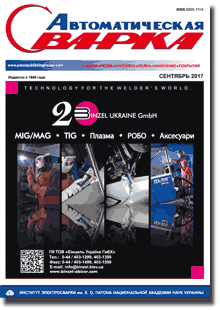| 2017 №09 (08) |
DOI of Article 10.15407/as2017.09.09 |
2017 №09 (10) |

Avtomaticheskaya Svarka (Automatic Welding), #9, 2017, pp. 59-62
Approximate calculation of radius of weld transition to base metal of welded butt joint according to normalized parameters
A.V. Moltasov
E.O. Paton Electric Welding Institute, NASU 11 Kazimir Malevich Str., 03150, Kiev, Ukraine. E-mail: office@paton.kiev.ua
Abstract
The aim of the present work was to establish mathematical dependencies between geometric parameters of welded bead, taken into account the stress concentration factor in welded butt joints and standard parameters of height and width of weld reinforcement during calculation. It was suggested to describe fillets and a convex part of the reinforcement of a welded butt joint in the form of arcs of contacting circumferences, which allowed establishing the functional relation between the side angle and the height-to-width ratio of the reinforcement. Using this relation, the values of the height-to-width ratio of the reinforcement and the values of radius of weld transition to base metal, corresponding to them, were determined on the basis of the known dependences of this radius on the side angle for different types of fusion welding. By plotting the regression dependencies using the computer-aided design system MathCad, the mathematical formulas were obtained to determine the radius of weld transition to base metal through the height-to-width ratio of the butt welded joint produced by submerged arc welding and welding in shielding gases. 13 Ref., 3 Tables, 3 Figures.
Keywords: welded butt joint, stress concentration, weld geometry, radius of weld transition to base metal, side angle, normalized parameters, approximate calculation
Received: 17.05.17
Published: 10.10.17
References
- Trufyakov, V.I., Dvoretsky, V.I., Mikheev, P.P. (1990) Strength of welded joints under alternating loads. Kiev: Naukova Dumka.
- Knysh, V.V., Klochkov, I.N., Pashulya, M.P. et al. (2014) Increase of fatigue resistance of sheet welded joints of aluminum alloys using high-frequency peening. The Paton Welding J., 5, 21–27. https://doi.org/10.15407/tpwj2014.05.04
- Belchuk, G.A., Naletov, V.S. (1972) On some dependencies of weld formation in zone of weld-base metal junction. Svarka v Sudostroenii, 79, 32–35.
- Belchuk, G.A. (1969) Welded joints in hull structures. Leningrad: Sudostroenie.
- Shonin, V.A., Poklyatsky, A.G. (2001) Low-cycle fatigue of welded butt joints made from alloy AMg6 in inert atmosphere. The Paton Welding J., 3, 18–22.
- Berezovsky, B.M., Stikhin, V.A. (1981) Peculiarities of transition zone formation from butt weld reinforcement to base metal. Voprosy Svarochn. Proizvodstva, 266, 99–106.
- Belchuk, G.A. (1964) Approximate calculation of geometric shape and stress concentration coefficient of welded butt joints on welding mode. Leningrad: LDNTP.
- Kaufmann, P. (1970) Ermuedungsverhalten von Stumpfnaehten. Schweisstechnik, 20(1), 38–41.
- Patskevich, I.R., Ryabov, V.R., Deev, G.F. (1991) Surface phenomena in welding of metals. Kiev: Naukova Dumka.
- Pankov, V.V., Pankov, S.V., Bogorodsky, I.G. et al. (2015) Measure function of weld as the basis in development of digital technologies of weld quality. Neftegazovogo Stroitelstva, 2, 20–26.
- Alekseev, E.R., Chesnokova, O.V. (2006) Solution of problems of computational mathematics in packets Mathcad 12, MATLAB 7, Maple 9. Moscow: NT Press.
- Bugrov, Ya.S., Nikolsky S.M. (2004) Higher mathematics: Manual for inst. of higher education. Moscow: Drofa. Vol.2: Differential and integral calculus.
- Makhnenko, V.I., Mosenkis, R.Yu. (1985) Calculation of stress concentration coefficients in joints with butt and fillet welds. Svarka, 8, 7–18.
